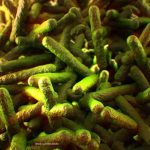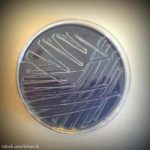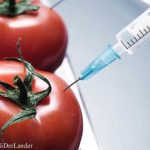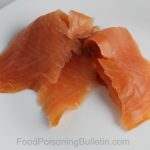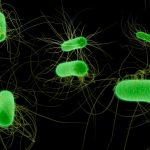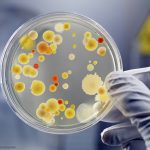A study published in the Journal of Food Science found that extracts from pecan shells should protect meats against the growth of Listeria monocytogenes bacteria. The University of Arkansas was the center of this study. Unroasted and roasted pecan shells produced antimicrobials tested against Listeria serotypes. Scientists found that the solvent-free extracts inhibited Listeria strains at minimum inhibitory concentrations of 0.38%. The antimicrobial effectiveness tests on poultry skin found that pecan shell powder exhibited a 2 log reduction of Listeria strains. The extracts produced a greater than 4 log reduction of an inoculated cocktail mix of Listeria strains. Since pecan shells are a by-product of the shelled pecan industry, they are easy to access and are very inexpensive. The … [Read more...]
Scientists Studying E. coli Blocking Effect on Immune System
Researchers at Kansas State University are studying how the E. coli O157:H7 bacteria blocks the human immune system to cause illness. The bacteria uses proteins to block the immune system, letting it multiply and release toxins into the bloodstream. Dr. Philip Hardwidge is the lead scientists for this study. He said, "in terms of infectious disease, this inhibition of the human innate immune response is absolutely critical for the bacteria's ability to cause an infection. If we can identify choke points in the interaction between the bacterium and the host, we may be able to inhibit the bacterium and prevent its survival in an infected human being." The National Institutes of Health is providing the grant for this study. Scientists are looking at a protein the bacteria expresses … [Read more...]
Researchers Studying E. coli Bacteria in Five Year Project
A major five year research study is looking at E. coli bacteria in beef and how to control it in the food supply. The University of Nebraska-Lincoln is heading up the study, along with scientists at Kansas State University and other institutions such as New Mexico State University and the University of California-Davis. Shiga toxin-producing E. coli (STEC) bacteria cause serious illnesses, including hemolytic uremic syndrome, in hundreds of thousands of Americans every year. Of the 500 known STEC bacteria, 100 can cause human disease. The 5-year study involves 48 scientists from 11 land-grant universities and other institutions who are conducting integrated research on the eight types of STEC bacteria. Chavonda Jacobs-Young, acting USDA National Institute of Food and Agriculture said, … [Read more...]
Creating a Probiotic Chicken
A research team working at the Institute of Food Research in the UK has been looking into coating chicken feathers with probiotics to combat pathogenic bacteria. The research is published in the Journal of Biological Chemistry. Lactobacillus johnsonii is applied to the coat and feathers of the chicken. Researchers discovered this then excludes Clostridium perfringens from the chicken's intestines. That bacteria causes necrotic enteritis in the poultry and sickens humans. The bacteria has a "coat" made of exopolysaccharides (EPS) that help the bacteria fend off stress and aid colonization. Scientists think that the EPS coat helps it outcompete C. perfringens. When chickens are slaughtered, bacteria in their intestines can easily contaminate the flesh. And in the U.S. and in the UK, … [Read more...]
Research Maps Campylobacter Chromosomes
New research from the Institute of Food Research has mapped chromosomes of Campylobacter. Scientists are trying to understand how this pathogenic bacteria controls its genes to develop new strategies to fight it. In the UK, Campylobacter is the most common cause of foodborne diarrheal illness. The chromosome map shows where all of the bacteria turns on its genes. Those are called transcriptional start sites (TSS). The bacteria turns on different genes in response to changes in its environment. TSS are also how the bacteria evolved to adapt to new situations. All organisms have these control mechanisms. The scientists used a technique called Differential RNA Sequencing. The high resolution map that was generated shows that Campylobacter has many more TSS than predicted. Scientists … [Read more...]
No Scientific Consensus on GMO Safety
The European Network of Scientists for Social and Environmental Responsibility (ENSSER) has released a statement that there is "no scientific consensus on GMO safety." The statement was signed by more than 90 scientists, academics, and doctors. The statement was issued in response to comments by some GM seed developers, scientists, and journalists who have said there is a consensus on GMO safety and that the debate on this topic is over. The signers say that "the claim that [scientific consensus] does exist is misleading and misrepresents the currently available scientific evidence and the broad diversity of opinion among scientists on this issue. Moreover, the claim encourages a climate of complacency that could lead to a lack of regulatory and scientific rigour and appropriate … [Read more...]
NDSU Researchers Find Chocolate Compound Combats E. coli
Researchers at North Dakota State University may have found a way to fight pathogenic E. coli bacteria. They discovered that B-phenylethylamine (PEA), a mood enhancer, reduces the number of E. coli cells in beef broth. PEA is the substance in chocolate that makes you feel good. PEA also reduced the amount of E. coli biofilm in beef broth. Biofilm is a collection of bacteria enclosed in an exopolysaccharide matrix that makes the pathogen much more dangerous, since it helps the bacteria protect each other and communicate. Bacteria in biofilms cause 60 to 80% of bacterial infections. And biofilms restrict the diffusion of antimicrobials. When exposed to PEA, E. coli bacteria can't produce flagella, the thin appendages that they use to move, bind together, and attach to surfaces. If they … [Read more...]
Researchers Make Breakthrough on Antibiotic-Resistant Bacteria
Researchers at the University of Texas Health Science Center in Houston have made a breakthrough in understanding how some antibiotic-resistant bacteria develop that resistance. The research was published in mBio journal. Food safety advocates are concerned about the increase of antibiotic-resistant bacteria on the foods we buy, especially raw meat. Many factory-farmed animals are fed sub-therapeutic doses of antibiotics to prevent disease and help the animal gain weight. Studies have shown that the numbers of antibiotic-resistant bacteria are increasing, and many bacteria are becoming resistant to more than one antibiotic. Scientists observed how bacteria responded to fluorescent labeled daptomycin, one of the "last resort" antibiotics in use today. The cells divert the antibiotic … [Read more...]
NIH Study Finds Removing Protein Helps Mice Fight Staphylococcus Bacteria
Staphylococcus bacteria can cause food poisoning when a person who carries it contaminates food and then that food is not refrigerated properly. The bacteria multiply quickly at temperatures over 40 degrees F and produce a toxin that makes you sick. Scientists at the National Institutes of Health may have found an alternative strategy to fight this bacteria; by deleting a certain protein in white blood cells. The protein Olfm4 or olfactomedin 4 interferes with white blood cell's ability to kill bacteria. A treatment may be developed that removes this protein, and that may make other therapies more effective. This strategy may be important as more bacteria develop resistance to antibiotics. Dr. Griffin P. Rodgers, director of the National Institute of Diabetes and Digestive and Kidney … [Read more...]
